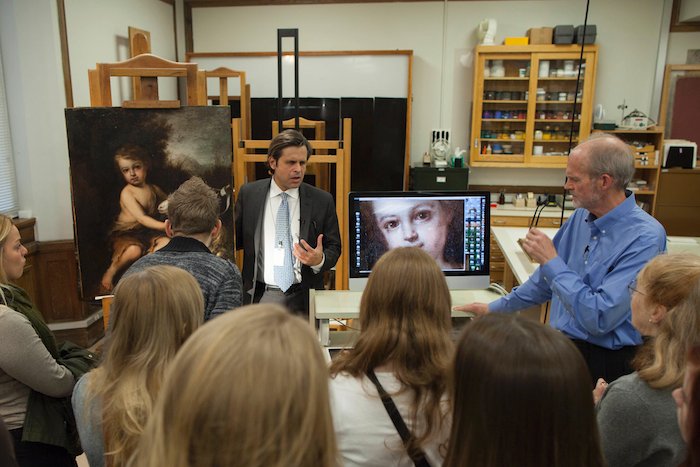- Department of History
Department of History
Varner Hall, Room 415
371 Varner Dr.
Rochester,
MI
48309-4482
(location map)
(248) 370-3510
fax: (248) 370-3528
DIA displays Murillo painting re-discovered at Meadow Brook Hall
After three months of analysis and conservation treatment, a significant painting by 17th-century Spanish artist Bartolomé Esteban Murillo went on display at the Detroit Institute of Arts (DIA) on Feb. 6. The Infant Saint John the Baptist in the Wilderness, painted around 1670, was re-discovered at Meadow Brook Hall, a historic house museum, by a DIA curator and will be on loan to the museum for five years. This is the first time the painting will be exhibited at a U.S. art museum.
Salvador Salort-Pons, DIA executive director of Collection Strategies and Information and curator of European paintings, was at Meadow Brook Hall last year when the painting caught his eye, and he identified it as an outstanding example by the Spanish Golden Age master. "Murillo produced this masterpiece when he was at the height of his powers," said Salort-Pons. "He was the first internationally known Spanish artist, and this Infant Saint John is one of the first Murillos to arrive in the U.S."
As part of the collaboration between the DIA and Meadow Brook Hall, an auxiliary of Oakland University, a series of visits by undergraduate art history and studio art, history, communication and chemistry students was built in so they could observe the scientific analysis and conservation that DIA specialists undertook on both the painting and its frame. The students had the rare opportunity to see DIA scientists and conservators at work and to have access to information produced only in the world's top museums.
"At the DIA we have the expertise and equipment to study works of art and to gain extraordinary insight about them," said Salort-Pons. "It is a fascinating process with remarkable results, and it has been a pleasure sharing our working methods and scholarly approach with OU students. This experience is an example of the learning opportunities the DIA can provide, the great resource the museum is for our region and the sorts of collaborations we seek with Michigan institutions."
In the 1600s the painting belonged to Italian merchant Giovanni Bielato, who donated it to Capuchin Convent of Genova. During the 1800s, it was sold to the family of the Duke of Westminster in London and in 1926 entered the collection of Alfred G. and Matilda Wilson, who kept it in their home, Meadow Brook Hall. This Murillo was exhibited in the Royal Academy in London in 1883.
"The collaboration has been especially significant—and truly unique— for the three parties' educational missions," said Geoffrey Upward, executive director of Meadow Brook Hall. "The project allows students and faculty at Oakland University, which was founded by the Wilsons, to observe firsthand the complexity and impact of conservation work, and to expose them to conservation as a potential profession. And, of course, the DIA can better educate its audiences about how a critical work of art helps us learn about our past and how vital the institute is to that pursuit."
Salort-Pons said the DIA owns two other painting by Murillo, The Flight into Egypt and the Immaculate Conception, which will be displayed together with Meadow Brook's The Infant Saint John in the museum's main European Paintings gallery.
 |
| As part of the collaboration between the DIA and Meadow Brook Hall, an auxiliary of Oakland University, a series of visits by undergraduate art history and studio art, history, communications and chemistry students was built in so they could observe the scientific analysis and conservation that DIA specialists undertook on both the painting and its frame. |
